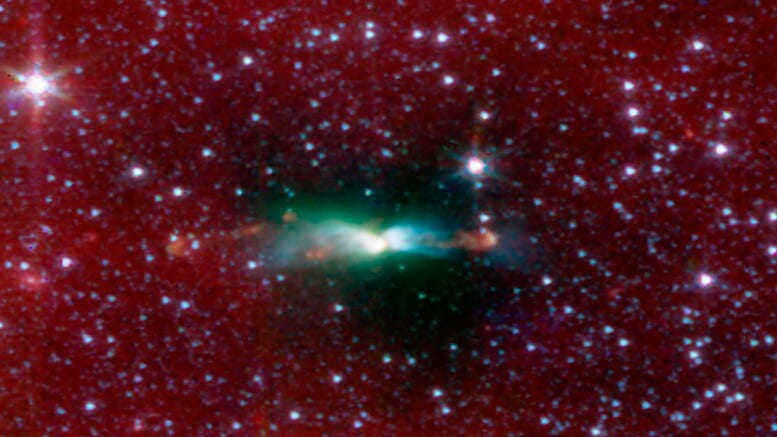New study helps researchers learn more about star formation in deep space
June 28, 2022

New findings from a team of Northwestern University astrophysicists provide insight into binary star formation and how magnetic fields influence the earliest stages of developing stars. Using NASA’s Stratospheric Observatory for Infrared Astronomy (SOFIA), the researchers were able to take a closer look at L483, a star forming cloud in deep space. They noticed the cloud’s magnetic field was twisted and that a newborn star was tucked behind it.
The study was led by Erin Cox, a postdoctoral associate at Northwestern’s Center for Interdisciplinary Exploration and Research in Astrophysics (CIERA). According to Cox, this new work could provide new insights into how binary stars — and the planets that orbit them — form. Cox presented the research at the 240th meeting of the American Astronomical Society in Pasadena, California. The study was also published in The Astrophysical Journal.
“Learning how binary stars form is exciting because planet and star formation take place at the same time, and binary stars dynamically interact with each other,” Cox said. “In our census of exoplanets, we know planets exist around these double stars, but we don’t know much about how these planets differ from the ones that live around isolated stars. With new instruments coming online to discover and probe new binary systems, we will be able to test these results with a statistical sample.”
Learn more about the findings in Northwestern Now’s story “Wandering star disrupts stellar nursery.”
Space

First Radio Pulses Traced to Dead-Star Binary
March 12, 2025
An international team of astronomers, including a Northwestern University astrophysicist, has traced a series of mysterious radio pulses to an unprecedented home. Starting a decade ago, astronomers have detected a pulse of radio emission every…

Flickers and Flares: Milky Way’s Central Black Hole Constantly Bubbles With Light
February 18, 2025
The supermassive black hole at the center of the Milky Way appears to be having a party — and it is weird, wild and wonderful. Using NASA’s James Webb Space Telescope (JWST), a Northwestern University-led…

Black Holes’ Spins Align in a Valentine’s Embrace
February 14, 2025
Most people have heard of “love at first sight.” But how about “love at first collision?” In a study fit for Valentine’s Day, Northwestern University astrophysicists discovered that binary black holes — when formed in…

Astrophysicist Adam Miller Receives Cottrell Scholar Award
February 13, 2025
Northwestern University astrophysicist Adam Miller has received a 2025 Cottrell Scholar Award from the Research Corporation for Science Advancement (RCSA), the United States’ first foundation wholly dedicated to science. Miller is among a diverse group of 16…



